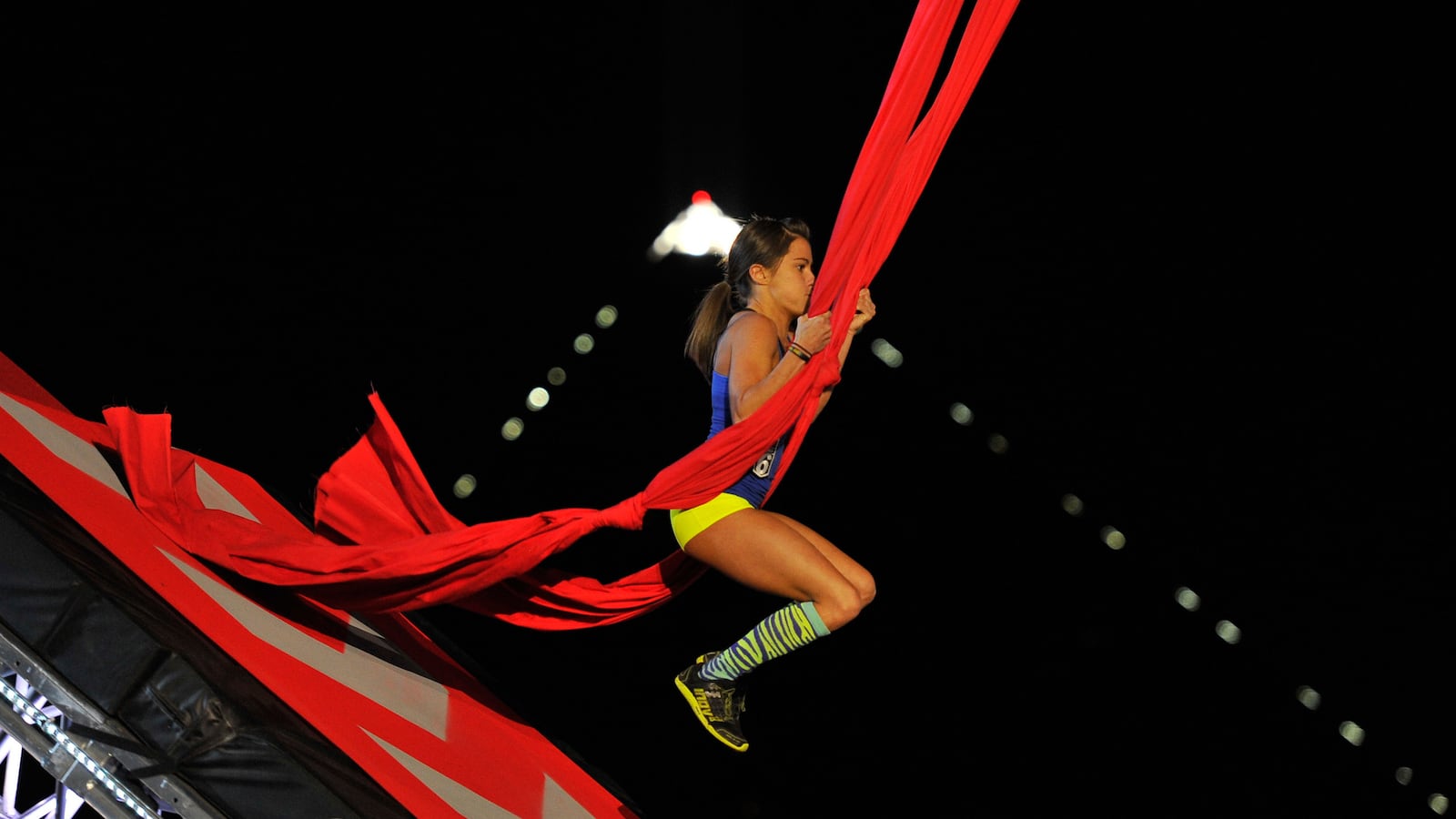Rather than the black camouflage in which they are commonly depicted, legend has it that the first “proto”-ninja disguised himself as a woman to assassinate a rival. It is fitting then, that New Jersey native Kacy Catanzaro may become the American Ninja.
Catanzaro is the first woman to reach the finals in the Esquire Network’s American Ninja Warrior. Adapted from the Japanese bi-annual competition Sasuke, the sport’s competitors run through an obstacle course that tests a variety of physical abilities.
She is as confident over the phone as she is climbing across one of Ninja Warriors many daunting obstacles. As well she should be, her physical strength and athletic control recall the godlike prowess of the great Makoto Nagao, Kazuhiko Akiyama, and Yuuji Urushihara, the only champions in Sasuke's seventeen year history. “That's what makes Ninja Warrior different from traditional ball sports,” she says in an exuberant voice from a vacation in one of North America’s oldest resort towns, beautiful Cape May, New Jersey.
This year, Esquire held regional Ninja Warrior challenges across the nation. Obstacles varied by location, but some constants include Ninja Warrior staples: the Spider Climb, a forty foot scramble between two walls with no grips or ledges, the Salmon Ladder, in which a loose bar is used to climb from level to level, and the Warped Wall, a ledge hanging over a 4.2 meter quarter pipe.
The first Japanese competition was held in 1997. In that time, only one woman has ever completed a stage, Chie Tanabe. Two other women advanced to the Las Vegas finals with Catanzaro, Michelle Warnky and Meagan Martin, but they have already been eliminated. The American version has been on the air since 2010, first on the G4 Network (which also licensed rebroadcasts of the Japanese version) and now Esquire and NBC. While the tournament has been filmed—contestants are under strict orders not to discuss the results—Catanzaro’s run is scheduled for Labor Day.
Catanzaro grew up in Belleville, NJ, where a love of gymnastics translated into a full athletic scholarship for the sport at Towson University. When she graduated in 2013, she moved to San Antonio, Texas. She is back in New Jersey visiting family with her boyfriend and trainer, Brent Steffensen.
“I watched the Japanese version with my dad growing up,” Catanzaro says. “I always felt like I could do it, but it seemed like it was always out of reach.” The American version of Sasuke premiered in 2009 when Kacy was enrolled at Towson University and unable to compete. Looking for a new challenge after graduating from university, she got in touch with Brent Steffensen and the Ninja Warrior community.
Steffensen came up with the workout Catanzaro used to train for the competition and they go through it together multiple times per day. It paid huge dividends when Catanzaro finished the Denver qualifier in 8 minutes 59 seconds and 53 hundredths of a second.
Her run through the course was watched on YouTube over 8 million times.
“I mostly do body training workouts,” she says. “A lot of pushups, squats, lunges, z-ups. Guys with a lot of muscle sometimes find it hard to hold up all that weight. It’s important for obstacles to be light and lean.”
The range of skills tested in the Ninja Warrior obstacle course are diverse enough that the competition is gender inclusive. Executive Producer Kent Weed recently told Entertainment Weekly that there had originally been talks of a woman only competition, but they decided to instead design more gender neutral obstacles.
In Japan, women compete in Sasuke, but there is also a woman’s only competition, Kunoichi. Rather than the upper body strength challenges that dominate Sasuke, especially in later stages, Kunoichi tests competitors’ balance and strategy.
At an even five feet tall, Catanzaro is the shortest competitor in this season of Ninja Warrior, but average for a gymnast. She excelled in her college career. Former coach Vicki Chliszczyk recently told WBAL TV, “When she was on the floor she just lit up the arena.”
“Gymnastics helped me prepare. Especially mentally,” Catanzaro says. “Competing against other people, and with everyone watching you. It can be hard to concentrate.”
She says learning how to compete in gymnastics helped her remain calm, so she could gain control of her body as it operated at levels of peak efficiency.
“You only get one shot. Whether you go down immediately, or on a later obstacle. You only get one shot,” Catanzaro says. “Even if no one was around it would be tons of pressure. You want to prove it to yourself that you can do it. And then on top of that, the audience is watching you. Millions of people on TV are going to watch later on. It’s all this pressure rolled into one moment. Knowing how to compete helped me gain control. I could stay calm enough to let my body do what it’s supposed to do.”
On the day of the competition, Catanzaro goes through the workout one more time. “To wake up the muscles” she says. “Nothing crazy. You don’t want to be sore and you don’t want to be stiff. The competition isn’t until night so we practice in the morning and then relax during the day.”
Catanzaro recently drew compliments from Olympic gold medalist Nastia Liukin who said, “I think a lot of people underestimate the amount of strength it needs to be a gymnast especially as a girl. The amount of strength, flexibility, stamina, everything it takes to be a gymnast is insane. She's incredible. She's amazing.”
Because women’s sports have struggled for coverage in traditionally male-dominated media markets, it’s all that much more satisfying to see Catanzaro outcompete male competitors in a mixed gender competition. Writing for Bitch Magazine, Mali D. Collins said, “As a consistent consumer of all things basketball and a self-identified sports lover, I can confidently say that the Don Imus scandal is still the most extensive coverage women’s basketball has had in years.”
The recent success of all-star Little League pitcher Mo’ne Davis shoveled more dirt on the myth of gender exclusivity in sports competitions. But critics of their accomplishments also highlight how women in male-dominated sports have to work twice as hard and face challenges that don’t affect their male competition. Evelyn Shoop’s recent examination of the issue for The Daily Beast cited a study by the Center for Feminist Research at the University of Southern California which showed ESPN’s coverage of women’s sports declined by almost half from 1999 to 2010.
“There are people who say it’s not a sport,” Catanzaro says. “They think it’s just a TV show. But it involves traditional sport training.”
If Catanzaro finishes on September 1, she’ll go on to the second and third stages. Stage Two is timed and must be completed in two minutes and five seconds, and includes challenges like the Double Salmon Ladder and the Butterfly Wall. Stage Three is again untimed, but tests athletes with obstacles like the Hang Climb and the Doorknob Grasper. In the past five seasons, no one has finished the third stage.
“It’s the new sport,” Catanzaro says. “It’s up and coming, extremely challenging. It’s super fun to be in a non-traditional sport. We break boundaries. I had no idea how many people would be so excited. People come up to me and share their stories. It touches my heart.”






